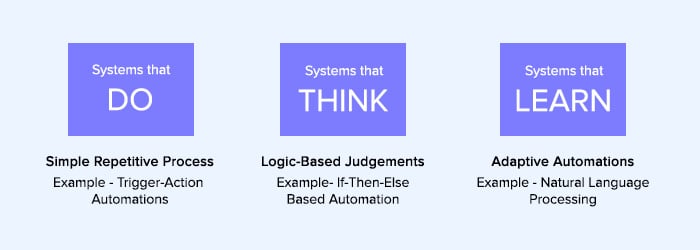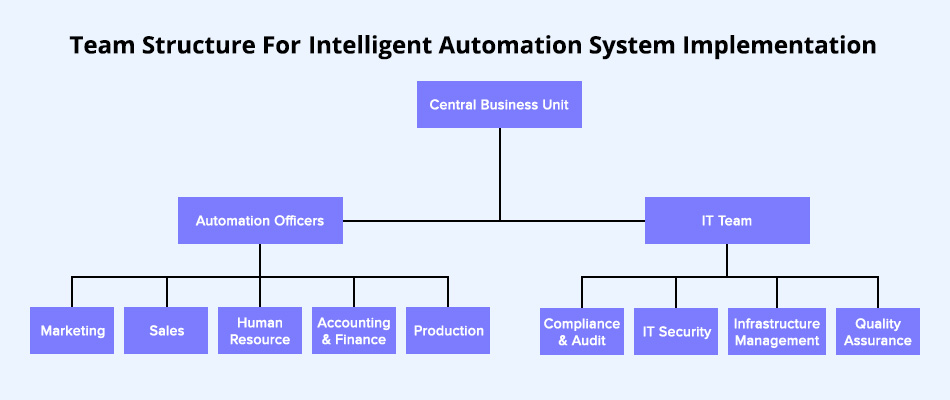infoTECH Feature
How to Implement an Intelligent Automation System for Your Enterprise

History has shown repeatedly that the two elements that consistently prove to be major growth drivers for any enterprise are experience and productivity. A positive experience for customers, employees, partners and vendors can easily become the differentiating factor for an organization looking to capitalize on organic growth using the word of mouth. Similarly, productivity gains by eliminating redundant processes, increasing employee satisfaction, or by improving process efficiency, can increase agility and speed of innovation in an enterprise.
The one key strategy that achieves both these outcomes simultaneously is the use of intelligent automation systems that not only acts as a business advantage but can also be the tool for survival in a competitive industry.
What is an intelligent automation system?
Simply put, intelligent automation systems use the power of artificial intelligence and process automation to create smart business solutions that think, learn, and adapt. They act as additional brainpower for your organization to reduce cost, improve accuracy, and to enhance the human effort.
Broadly, the continuum of an intelligent automation system covers three components - systems that do, systems that think, and systems that learn, each of them affecting key business functions.

But implementing an intelligent automation system can be tricky, especially in an enterprise environment where large teams, a multitude of siloed business applications, and complex internal processes makes it all the more difficult. However, this also presents a necessary opportunity to streamline business processes across the front, middle and the back office. But most importantly, it is the people, talent and structure behind the intelligent automation system that’s equally (if not more) important than the technology itself. Building the right cross-functional team that puts business objectives at the forefront will always be the key to building a scalable automation system.
So as we move forward, let me lay out a structured approach that can be used to formulate and implement an intelligent automation system in your organization.
Defining the goals and a 360-degree vision
Just like a business needs a comprehensive strategy to thrive in the market, you need a 360-degree strategy to build an intelligent automation system. Start by defining the core automation objectives which can range from improving data quality, reducing human errors, increasing operational efficiency to personalized communication with customers.
To build a list of automation opportunities, a central team needs to analyze every aspect of your business ecosystem and divide the opportunities in three categories:
- Simple automations: Automations in this category follow the trigger-action model and are ideal for non-cognitive workflows that are time-consuming, error-prone, and expensive. They take away the pain of the mundane and are usually implemented to transfer data by connecting two disparate business applications. For example, posting social media updates when you publish a new blog post or updating a new employee’s information in your payroll system from your HR application automatically. A study by Netspoke revealed that enterprises use an average of 1,295 cloud services which indicates the scope of opportunities available in this category.
- Logic based automations - this category of automations include multi-step workflows and automations based on conditional logics like ‘if-this-else’ or switch statements that can run in parallel or sequential flows and have a limited set of outcomes. For example, triggering a user onboarding flow based on the industry and role of the customer or triggering dunning emails based on the reason for payment failure.
- Adaptive automations - mostly driven by complex algorithms and artificial intelligence, these automations are capable of analyzing vast amounts of dynamic and unstructured input, and execute processes that are highly dynamic and non-rules-based. Natural Language Processing, Intelligent Character Recognition(ICR), Image Processing, and Speech Processing are all part of adaptive automations. Examples include software testing where automation can mimic user interactions or anti-spam systems like CAPTCHA that work without user input. In fact, Google used DeepMind AI to reduce its energy consumption for data center cooling by 40%.
Building and training a cross functional team
After analyzing the scope of automation opportunities, the next step is to build a cross-functional team. Since the priorities differ across departments, involving stakeholders from each major team is essential for the success of this endeavour.
An automation officer can be appointed in every department whose mandate would be to consult with their team and come up with automation opportunities which can be used to build the overall objectives of your intelligent automation system. You would also need to demonstrate how this initiative will help the teams to get the full support from your automation officers. Very often, it’s the lack of buy-in from the team that leads to the underwhelming performance of an automation system.
Even though most of the automation requirements will be driven by business teams, your IT team will be the backbone of the project. They’ll play a central role by translating the requirements of the non-IT teams in building and scaling the automation system. Apart from creating integrations and workflows, they will also tackle the critical areas like compliance and audit, IT security, infrastructure to support scalability, among others.
A conducive organization structure to implement the intelligent automation system can contain a federated central unit that’s connected to different teams via automation officers with the IT team sitting in the middle.

Prioritization and Implementation
The prioritization of the automation opportunities should be based on two principles that will achieve the highest ROI - which automations can make the biggest impact on core business metrics and which ones can be implemented the fastest. This indicates that the processes involving elimination of human errors or mundane repetitive tasks would be prioritized first. However, this should not mean that we compromise experience for productivity. Any process that can significantly improve the customer experience by reducing the product delivery time or by reducing the response time to customer queries should also be prioritized.
After the prioritization, an implementation plan is drafted containing the details of all the automated processes to be developed, how they will work, what tools/applications are required to build them and the KPIs to measure their performance. Subject matter experts should be involved to avoid any foreseeable problems and peer-review should be conducted to strengthen the proposed plan.
Finally, when the development of the intelligent automation system is complete, rigorous testing is conducted to find gaps and errors. Exception handling provisions should be built in to facilitate manual intervention and IT capability should be maintained for regular oversight of the automated processes in case they do not work as expected.
Final Thoughts
It is no surprise that many companies fail to move beyond the pilot stage in the implementation of intelligent automation systems because they incorrectly estimate the scope of the project or lack the resources required to see it through. Avoiding these mistakes and getting your team to buy-in this strategic initiative will play a key role in the success of your automation program. As for implementation, start small and roll out the full system in multiple phases so you see the results of each phase, which will not only motivate your team but will enable them to scale the automation system across your enterprise.
About the Author: Ashok Gudibandla is the CEO of Automate.io, a no-code workflow automation platform that helps businesses build one-on-one or multi-app workflows without needing to write a single line of code. Ashok has over 10 years of entrepreneurial experience in enterprise and SaaS (News - Alert) application domain. With 30,000+ customers including Fortune 500 companies, Ashok is on a mission to bring the power of automation to every business.
Edited by Maurice Nagle
infoTECH Headlines
What Is AWS EFS? Features, Use Cases, and Critical Best Practices
Cost-Effective Approaches to s1000d Conversion
A virtual crossroads for technology enthusiasts
Benefits of employee monitoring software in preventing overworking of workers
CI/CD: Trends and Predictions for 2024
Technical Documentation for IT: A Practical Guide
Managing Your Costs on AWS: A 2024 Guide
What Is Application Dependency Mapping?
Top 5 Kubernetes Errors and How to Solve Them
How Artificial Intelligence Can Improve the World of Online Gaming Platforms
Rich Tehrani
Rich Tehrani



 By
By 
